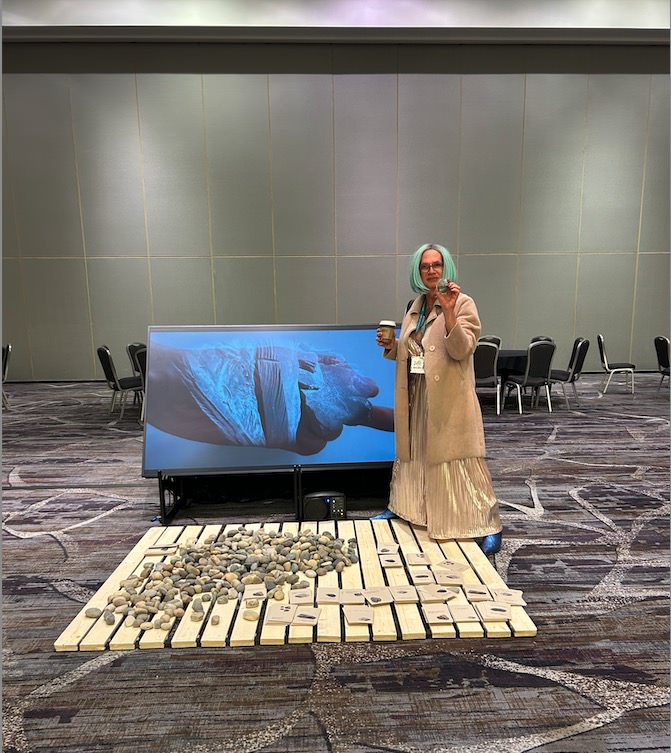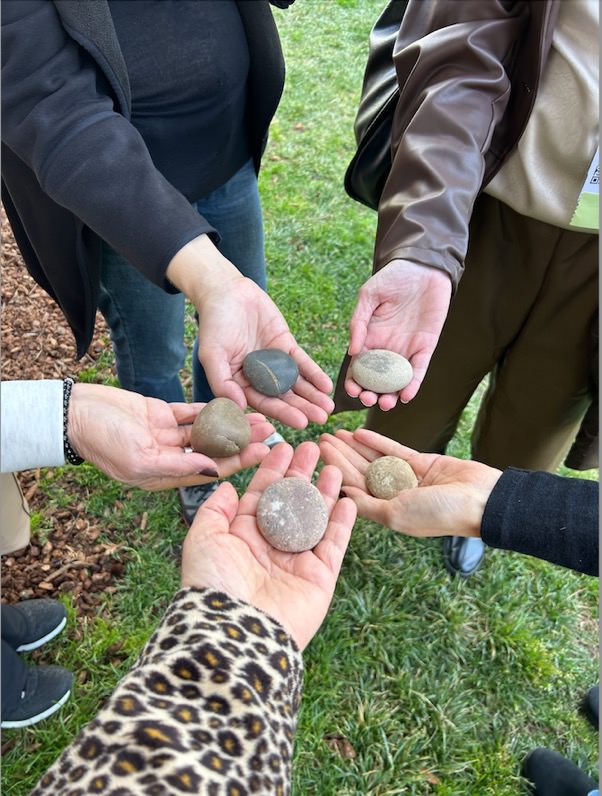
Fig 1. Brigitte Baptiste selecting a stone from Moving with Rocks at LASA2025, San Francisco.
When we began organizing LASA2025, we commissioned María José Arjona—a prominent Colombian transdisciplinary visual artist focused on performance—to develop a project that expanded on her ongoing inquiry into the reciprocal influences between the human and the non-human. Arjona proposed an ambitious performative and transdisciplinary experiment involving local and scientific communities. The project explored specific sites, selected rocks, and facilitated their safe transport and installation. The final live performance was intended to integrate choreographed movements and interactions with the rocks, creating a collective experience that engaged both participants and audience. It culminated in a collaborative workshop led by Arjona during the LASA2025 Congress, examining the performative and political implications of physically interacting with rocks as non-human entities.
Unfortunately, due to the current anti-immigrant climate, Arjona was unable to travel to San Francisco, and we had to pivot to an alternative approach. In her absence, the stones themselves became the catalyst for a long-durational performance. To this end, Arjona produced a video, designed postcards, and created an installation featuring “immigrant” Mexican river stones, which were made available for the public to collect. Following the artist’s instructions, participants were encouraged to choose a rock and carry it with them throughout the conference. In Arjona’s words: “This act symbolizes our commitment to creating space for those who cannot or are unable to remain in the United States.”
On the final day—May 25th at 5 p.m.—participants were invited to gather in a circle. Each person was welcomed to share a word, a thought, or a moment of silence reflecting on our collective values, fostering free expression and political action. As the artist stated, “This ritual aims to open up space for all forms of life.”
As we prepared to deinstall Moving with Rocks, we felt that its movement had not yet reached its final cycle. We therefore offered the project to the legendary Galería de la Raza, located in the heart of San Francisco’s Mission District.
For LASA2025, we invited Ani Rivera, director of Galería de la Raza, to participate in a panel discussing the role of cultural organizations in supporting Latinx and Chicanx art and culture, while also nurturing community life and championing social inclusion, justice, and equality. Earlier in the planning process, Ani had offered to connect us with dancers and provide rehearsal space for Arjona’s performance. While that vision did not materialize, Ani’s acceptance of Moving with Rocks into Galería de la Raza gave the project a new home and expanded the final circle—creating a form of symbolic justice.
Moving with Rocks will be reactivated in August for the community. Once the project concludes, the remaining stones will find a permanent home in the institution’s garden.

Fig 2. Postcards designed by the artist for Moving with Rocks
We reproduce the statement that María José Arjona wrote for this project.
A TECTONIC SHIFT: EMBODYING MEMORY AND RESISTANCE
Maria José Arjona
This proposal, emerging at the intersection of political turmoil in the US, two ongoing wars, and a massive return to discrimination based on gender, race and beliefs, envisions a transformative act of political and cultural reconfiguration. Moving with Rocks, envisioned as a long duration performance piece, is now transformed into an invitation for participants able to assist LASA 2025, to reimagine the rock—not merely as an inert object, but as a dynamic archive of memory, identity, and resistance.
In many indigenous traditions across Latin America, rocks have long served as silent witnesses to history: they are repositories of ancestral narratives, ritual instruments, and living maps of the land. This project draws upon that legacy, proposing that the act of moving, sharing, and reassembling these stones becomes a powerful gesture—a micro-revolution in itself. Each pebble, small yet potent, transforms into an emblem of defiance against both historical and contemporary oppressions.
At its core, Moving with Rocks challenges the dichotomy of permanence versus fluidity. As water carves its ever-changing path through the solid earth, so too do our actions disrupt established orders and invite new forms of social and political possibility. The rock, in this context, embodies the tension between solidity and transience: it is both an entity of the past and a catalyst for future transformation. In moving a rock, one does not simply shift a mass of stone; one reclaims a piece of history, re-articulates a narrative, and reasserts the right to belong.
This happening unfolds as a series of ephemeral yet meaningful gestures throughout LASA 2025. Participants are invited to TRANSPORT, LOCATE, and INSTALL small rocks in everyday spaces, thereby weaving a silent network of collective memory and resistance—a river. Whether a rock is carried throughout a day, exchanged with a stranger, or arranged into a spontaneous sculpture, each act becomes a ritual of reconfiguration—a subtle subversion of a political climate that marginalizes migrants and minorities.
In this landscape of interconnected forces, the interplay between the immovable and the mutable is not merely metaphorical; it is an active site of contestation. Like water that softens the hardest stone over time, our small, deliberate acts accumulate into a tectonic shift—a reimagining of how we coexist, honor our differences, and nurture reciprocity. This practice redefines what it means to modify our surroundings: it is a call to continuously transform both our internal and external landscapes, to become “that other thing” that disrupts and reclaims power.
Moving with Rocks is a living, participatory process. By engaging with these natural entities, we not only trace the genealogy of the earth but also inscribe a future where resistance, memory, and hope coalesce into a vibrant, ever-evolving narrative.

Fig. 3. Final day circle, Moving with Rocks, Yerba Buena Garden, San Francisco.

Fig. 4. Handing over Moving with Rock to Ani Rivera and Ivette Diaz at Galería de la Raza.

